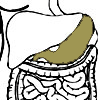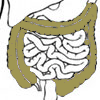
What does the Digestion System do ?
NOTE: Google’s new policy on advertising prescription drugs does not let us mention the names of many of the body’s naturally occurring hormones. In this article we cannot mention the hormone secreted by the pancreas that controls the amount of sugar in you blood - clue it is often taken by diabetics. In this article the offending word is marked as Ins**in.
The Biology of Digestion
At no point in this description should we forget that the system we are viewing is infinitely more complex than our understanding allows us to see.
To lose sight of this great wonder, and replace it with our sterile, and wholly inadequate labels, is to rob yourself of the miracle of life - and the great tragedy that scientists are often responsible for.
The Stages of Digestion
Several different stages are required to break down the various elements that we are capable of using. Each stage maintains a particular environment specific to its requirements.
Mouth = Starch
The first stage of this process begins in the mouth itself, where the food is mixed with complex sets of enzymes, etc. in the saliva.
Starches (complex carbohydrates) are particularly affected by this process, as the successful action upon starch by the "friendlies" depends upon the presence of an enzyme complex called Ptyalin. In the absence of Ptyalin, ONLY the unfriendlies can work on the starch, producing alcohol and ethanol rather than fuels for the body. Ptyalin production in the mouth is inhibited by the presence of sugars (simple carbohydrates) or acids (vinegar, etc.). This is because acids and sugars have there own agenda in digestion and are rarely found together in our natural foods.
Also, taste triggers the release of the appropriate juices in their various locations throughout the intestines, so the entire system is instantly prepared for what it initially experiences.
Ex: A vegetable that tastes like a spice will confuse it the entire system.
Note: Once past the throat, the pulped and ensalivated mixture is known as Chyme.
Stomach = Protein
Highly acidic (up to 1pH), and very hot. Only very specialised microbes can remain here, and nearly none do. It is a great misunderstanding to say "stomach bug", as there is nearly no bacterial action here, almost all life is destroyed in environments as acidic as this. Even to say that nutrition is gained here is misleading. There is virtually no absorption of anything through the stomach walls.
The Stomach is the first stop in the food's journey, because its job is to start the breakdown of those elements that are the most troublesome and expensive to the system; proteins. Built of chains of Amino Acids, specific to the cells that built them, Proteins must be broken down in order to be rebuilt in the liver, into sequences appropriate to our cells. NO proteins that we eat are used as they are - all are broken into their component Amino Acids.
Incidentally, every cell in existence contains proteins that can be broken down in this way. No one to date has ever suffered from a 'lack of protein'. To prove it, ask your Doctor or nutritionist what the medical term is for this... There isn't one !
Of all usable substances, proteins take the longest, and are the hardest to digest. They leave the most mess behind them, and cost the most in terms of water and energy. The entire Stomach exists simply to initiate this breakdown, so that our friendly bacteria in the intestines can take the amino acids they need, and leave us what we need.
In the stomach, there is no action upon the other elements essential to life. Food will remain here for anything from 10 minutes to three hours, depending upon its protein content. All the protein not acted upon in this stage will go on to putrefy in the bowel over the next few hours, so food must not be hurried through this stage by overeating.
Liver = Fats
Fats (oils) are generally water repellant, and insoluble. For the body to utilise them it must first make them water-soluble. This is done by an interesting chemical phenomena called emulsification movement is one of the attributes of bile.
Secreted from the liver and held in the gall bladder until it is needed, the orange-coloured bile enters the system just after the stomach. If it is not called for (no fats present in this meal), then the Gall Bladder remains relaxed and the more concentrated emulsifying aspects of Bile remain there to concentrate further, so that when they are called upon, they will do they job most efficiently.
As the food passes from the stomach to the small intestines, it must be changed from VERY acidic ( >1 pH ) to VERY alkaline ( <14 pH ). This is another aspect of Bile, and another reason why it is called into the tract with such frequency.
Bile also carries with it much of the debris that is cleaned from the blood by the liver. The multitude of dead cells and immune debris leave the body via this route. Dead red blood cells give Bile it's colour, and make faecal matter brown, to the degree of its use.
Upper Small Intestine = Sugars
In this very alkaline place, much bacterial action goes on, friendly and unfriendly. Many starches are broken down into sugars (as long as the food had significant amounts of Ptyalin chewed into it) and are absorbed into the intestinal walls (along with the sugars eaten as sugars), to be carried to the liver for storage and distribution (after being converted to Glucose - the only sugar the body can utilize).
Also here is where most of the emulsified fats leave the intestinal tract for the liver, for further processing into the multitude of oils utilized by every cell the body. Only cooked fats are confusing and problem-causing to the body, ALL raw fats are convertible, useful, and necessary in the life of ALL cells and systems.
Processed sugars and starches slip through the floorboards of the intestines, and find their way into the blood stream, and then ultimately into the cells themselves, without being called for. Habitual use of them will stress the Pancreas, which must produce unnatural amounts of Ins**in to get the sugars out of the bloodstream, and into cells. Excessive sugar in the cells goes through the "Krebs Cycle" and if it cannot be utilized by the cell, (sugar-highs cannot go on forever!) the compounds are "hooked end to end" within the blood cells, and form a different compound commonly known as Hard Fat (as in Hard Cheese), and is shed back into the bloodstream. This sticky substance MUST then be stored in the Adipose tissues, in an attempt to stop it clogging arteries, but all defenses have their limitations.
Note 1: With constant over use, the Ins**in secretion glands in the Pancreas will fail, and conditions such as Pancreatis, and finally Diabetes are often witnessed.
Note 2: The race with the largest Pancreases are also those that feast on the greatest % of white rice in their diets, and the lowest raw veggies - The Philippinos.
Another avenue of action that leads to getting fat from eating processed sugars and starches, is bacterial. Our friendly bacteria are expecting sugars and starches that come conveniently packaged within the foods - alongside the necessary minerals and enzymes to aid their assimilation. In the event of processed foods, the body can do much to add enzymes from the Pancreas at this point, but it is nutritionally and energetically expensive, and will eventually exhaust supplies. However, while being difficult to digest, these unprepared sugars and starches are perfect for fermentation and the unfriendly bacteria have a field-day, multiplying uncontrollably and saturating the tract with aggressive and pathological toxins such as Ethanol, Alcohol (sugar-high is sometimes just fleeting inebriation), and gases, often with Methane and sulphur compounds (very dangerous gases for bacteria and beings alike).
Now we have several problems all at once.
An overgrowth of an unfriendly bacteria in an environment that is bloodless, thus immune-resistant, and very difficult to suppress. Often the solution is the general alimentary defence against invasion of any kind. The mucous membranes that line the tract secrete extra amounts of mucus, in the hope that the problem will just slide out of the system without too much damage to the lining itself. A great defence, and it only costs the body the nutritional content of the food it is letting slip away unassimilated. However, as we will see later, if this defence is utilized too often, it causes issues further down the tract.
The other immediate problem with overgrowth is the toxic bi-products of the unfriendly cell multiplication. Most of which are trapped in the Chyme itself (and now the mucus as well), and will later be assimilated by the intestinal lining as it attempts to coerce nutrients from the tract.
Note: A bottle of wine or beer can be engineered (by precise temperature control and sugar content) will stop maturing after a given time. This is because the debris from the fermentation process, becomes so poisonous within the liquid that it kills off the very bacteria that produced it. In the same way, both the toxic residues and the pathological gases in a fermenting bowel massacre both friendly and unfriendly bacteria alike.
Lower Small Intestines = Minerals & Vitamins
Only here does the real mining of elements begin. Until this point, the body has been secreting components that help our internal bacteria to break down foods to make assimilable the nutrients created by plants lower in the food chain. Oils, amino acids, sugars, etc., etc., all are strung together from their composite atoms by the plant world (wholly or in part). It is the plants (fueled in turn by the sun of course) that are the real creators of life, we are just the recyclers.
Even in the utilization of relatively simple particles such as minerals, we are dependent upon the plant kingdom to provide our bodies' with the correct enzymatic bridges necessary to collect and utilize even these elemental parts appropriately. The organic compounds that allow us to use them are somewhat fragile. Some cannot even withstand bombardment by unfiltered sunlight, or the chemical action of Oxygen. Some are more robust than others, but one thing that they all share is their susceptibility to heat. Once cooked (over 65 C), they all loose these complex organic structures. Then the body either has to recreate them as best it can, or simply go without that mineral. To drive the point home, I ask whether eating nails would help with an Iron deficiency ???
Vitamins are very similar in their integrity and fragility. Once taken over a certain temperature, they cease to be useful, and either have to be repaired or forgotten by the system.
Here it must be pointed out again that once denatured through the cooking process, most nutrients become inorganic (IE; split from the organic structures that the body is expecting them to arrive with), thus, they are more difficult for the body to utilize. Some may be reconstructed by our miraculous organs, and made useful once more, but much of them will burden the immune system and kidneys with the need to filter them out. We are designed to neutralize some degree of these material through millenia of drinking from streams, etc., but after many years of overuse the system may start to fail, blocking and confusing the systems of mineral distribution. IE: Stones may form in the delicate filters of the kidneys.
Appendix = Lymph Glands
If any of the above stages were not complete, here is where they begin to cause problems.
This tiny finger-like structure hanging from the base of the Colon - conveniently located right where the small intestine joins the large, is the body's largest Lymph gland, and a secreter of lymphoid material into the bowel. This is nature's insurance against a totally unchecked spread of unfriendly bacteria proliferating throughout the rest of the intestine, and is perfectly positioned at the area where Chyme enters the Large Intestine from the Small Intestine, IE; when a small pipe enters a bigger one there is a slowing in movement, and a fermenting mess would otherwise sit against the mucous membrane potentially compromising the integrity of the system.
No one seems quite sure how the immune-suppressive activities of the Appendix really manifest. However, it is clear that if this emergency measure is required to manage the balance of bacteria. However, if asked to function at top gear forever, then failure is inevitable as with all defences, usually after a long period of grumbling.
There is much controversy over the efficacy and even need for this much belittled organ. However, it has long been seen that after Appendectomies, the Lymph nodes surrounding the site where the Appendix used to be, always swell to spread between them the volume of the Appendix itself. Some people's even grow back ! Not so redundant perhaps...
Colon = Water & Minerals
In the final part of the system, there is as much to be reclaimed as there is to be gained. So many nutrients have been added to the Chyme on it's journey, that there wouldn't be much net profit from the venture without the Colon; the largest tube in the body. It starts busily to draw water, enzymes, minerals, vitamins, trace elements, etc., through the colon wall.
Here the water is drawn out of the Chyme, so as not to lose it unneccessarily, and too much excess mucus may begin to dry out, becoming more viscous, sticky and harder to move. This means it will spend more time in the Colon, and a constipation loop begins, increasingly dehydrating the material and inhibiting the passage of material.
This slowing of the bowel allows the proliferation and potential overgrowth of unfriendly bacteria, giving off toxic compounds instead of nutrients, which will find their way into the bloodstream, despite the best actions of the Appendix.
The Colon never encountered this situation throughout our evolution, and was therefore not designed to cope with it.
Moreover, the entire intestinal tract is based upon a series of circular muscles that move the Chyme by sequenced contractions. Like any other muscle, if they become underused (lack of fiber in food), they will atrophy. This gives them a greater tendency to get fall into disarray, leading to...
getting stretched too thin (ballooning through overeating and repressed gases).
being held permanently tense with unexpressed emotional trauma (a cultural trait, but also system).
twisted out of place, which is an extension of muscle deformation, mixed with underactvity in the abdominal wall, leading to full distention of bowel (through sedentary lifestyle).
Moreover, especially in the case of those peristaltic muscles held in tension, the muscle becomes less and less flexible, becoming less able to massage itself through normal rhythmic contraction and relaxation. Without this massaging effect, blood has only limited access, lowering the elimination of cell wastes, and distribution of oxygen and nutrients. A degenerative cycle is set up.
The underactive bowel also makes a great host for a larger worry, sometimes much longer than the person in which it resides. Parasites, primarily worms, can range from microscopic, to ½ metre long (Some Tape Worms have been recorded as 28 feet long - the length of the intestinal tract).
There is much concern about our parasitic content in some schools of natural health, and while we are theoretically riddled with them, my experience shows me that they are, on the whole, far more of a danger to our self-esteem than our well-being (though there are many notable exceptions). They are a very motivating and graphic way of evidencing the work to be done, but rarely fulfill the terrifying idea we have about them. If you have grown-up on a standard western diet without ever "cleaning-house", then you can guarantee that you are eating for more than just yourself. Anyone with pets, particularly dogs, will know of the advise that we should "de-worm" them regularly. But rarely is this scenario applied to humans - unless they have traveled through particularly poor areas of the world - such is our association between affluence and hygiene, but it is simply not the case.
Myriad fear-inviting titles have been coined for all these conditions, and for the further degenerations of the greater system, which occur if no improvements are made. It is neither beneficial to the situation nor educational to the individual (in the true sense of the word) to go into further details of what follows, besides it is an arena filled with even greater controversies than those described above.








